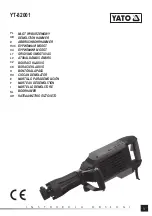
OPERATIONS
-21-
OPERATIONS
Starting Jointer
Basic Operations
Once assembly is complete and adjustments
have been made, the jointer is ready for a test
run. The purpose of a test run is to identify any
unusual noises and vibrations, as well as to con-
firm the machine is performing as intended.
1.
With your finger poised to hit the
STOP
but-
ton if there is a problem, turn on the joint-
er by pressing the
START
button on the
power switch.
2.
Once the jointer is running, listen for any
unusual noises. It should run smoothly with
little or no vibrations. If there are any
unusual noises or vibrations, shut the joint-
er off immediately. It should not be run any
further until the problems are corrected.
3.
Unplug the jointer and investigate the
source of the noise or vibration. DO NOT
make any adjustments to the machine while
it is plugged in.
4.
Repeat
Steps 1-4
until the jointer runs
smoothly.
Always wear safety glass-
es during operations.
Serious injury may occur
if this is warning is ig-
nored!
Always keep loose
clothing and long hair
secured and away from
moving parts.
All operations on the jointer are made by plac-
ing the workpiece firmly against the infeed table
and the fence, and then passing the workpiece
completely over the cutterhead.
Operational tips as well as specific types of cuts
are mentioned further on in this section. If you
are a beginner, practice each new type of cut
with the fence in the desired position, with the
tables set even, and the machine turned
OFF
.
Get a feel for board control and hand position,
and practice feeding the board across the table
while maintaining absolute control. When you
are ready for the actual cut, keep in mind that
shallow cutting depths allow you to have more
control.
Always wear a dust mask
and safety glasses in addi-
tion to using a dust col-
lector. This machine pro-
duces sawdust that may
cause allergic reactions
or respiratory problems.
DO NOT operate this ma-
chine without an ade-
quate dust collection
system. This machine
creates substantial
amounts of wood dust
while in operation.
Failure to use a dust col-
lection system can result
in short and long-term
respiratory illness.
















































